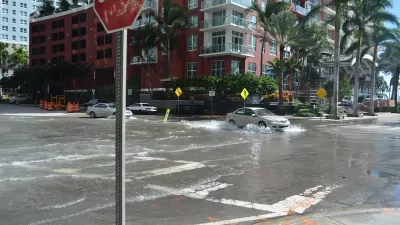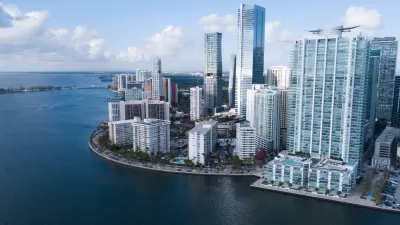Three years after its adoption, Sean McCaughan assesses the impact of Miami 21, first New Urbanist zoning code adopted by a major American city.
Miami 21, authored by Miami based New Urbanist leaders Elizabeth Plater-Zyberk and Andres Duany, was the firm's attempt to translate their policies, which had largely been tested at the suburban scale, to a fully urban environment, in their own backyard. McCaughan sees successes and failures at this early junction.
Of the failures, McCaughan sites the lack of adequate mass transit to support walkability, the design of the new Miami Marlins ballpark, and the lack of reduction in parking requirements. "The code is not complete. Miami 21 is stymied by the fact that it is not a code for a complete city, but only for its zoning. Miami's lack of quality mass transit is one of the city's worst obstacles to growth, and yet transportation planning was firmly beyond their jurisdiction. The long battle to enact the code also led to compromises and conformity on such matters as parking requirements."
McCaughan sees the code's early successes at a finer grain. "The strength of Miami 21 is not in big moves, like rail lines, or iconic public buildings. Miami 21's power is urban infill, density, and the vitality of the pedestrian experience at the neighborhood level."
FULL STORY: Comment> Miami's New Urbanist Experiment

Alabama: Trump Terminates Settlements for Black Communities Harmed By Raw Sewage
Trump deemed the landmark civil rights agreement “illegal DEI and environmental justice policy.”

Study: Maui’s Plan to Convert Vacation Rentals to Long-Term Housing Could Cause Nearly $1 Billion Economic Loss
The plan would reduce visitor accommodation by 25% resulting in 1,900 jobs lost.

Planetizen Federal Action Tracker
A weekly monitor of how Trump’s orders and actions are impacting planners and planning in America.

Wind Energy on the Rise Despite Federal Policy Reversal
The Trump administration is revoking federal support for renewable energy, but demand for new projects continues unabated.

Passengers Flock to Caltrain After Electrification
The new electric trains are running faster and more reliably, leading to strong ridership growth on the Bay Area rail system.

Texas Churches Rally Behind ‘Yes in God’s Back Yard’ Legislation
Religious leaders want the state to reduce zoning regulations to streamline leasing church-owned land to housing developers.
Urban Design for Planners 1: Software Tools
This six-course series explores essential urban design concepts using open source software and equips planners with the tools they need to participate fully in the urban design process.
Planning for Universal Design
Learn the tools for implementing Universal Design in planning regulations.
Caltrans
Smith Gee Studio
Institute for Housing and Urban Development Studies (IHS)
City of Grandview
Harvard GSD Executive Education
Toledo-Lucas County Plan Commissions
Salt Lake City
NYU Wagner Graduate School of Public Service





























